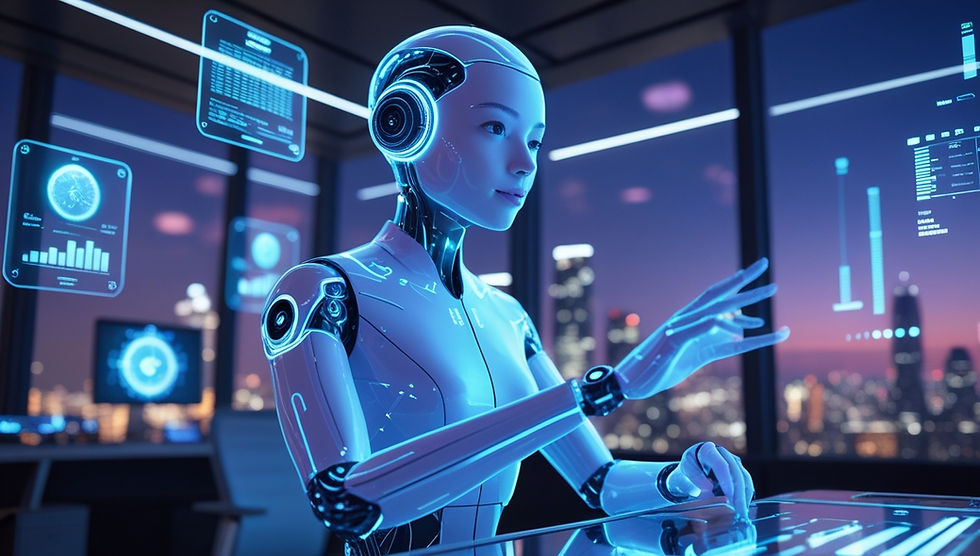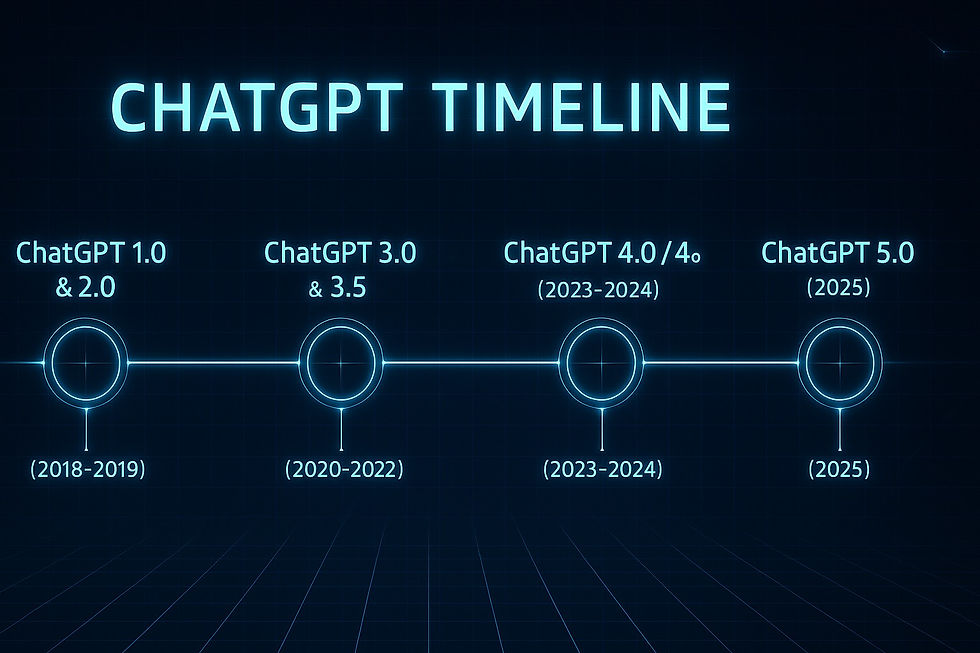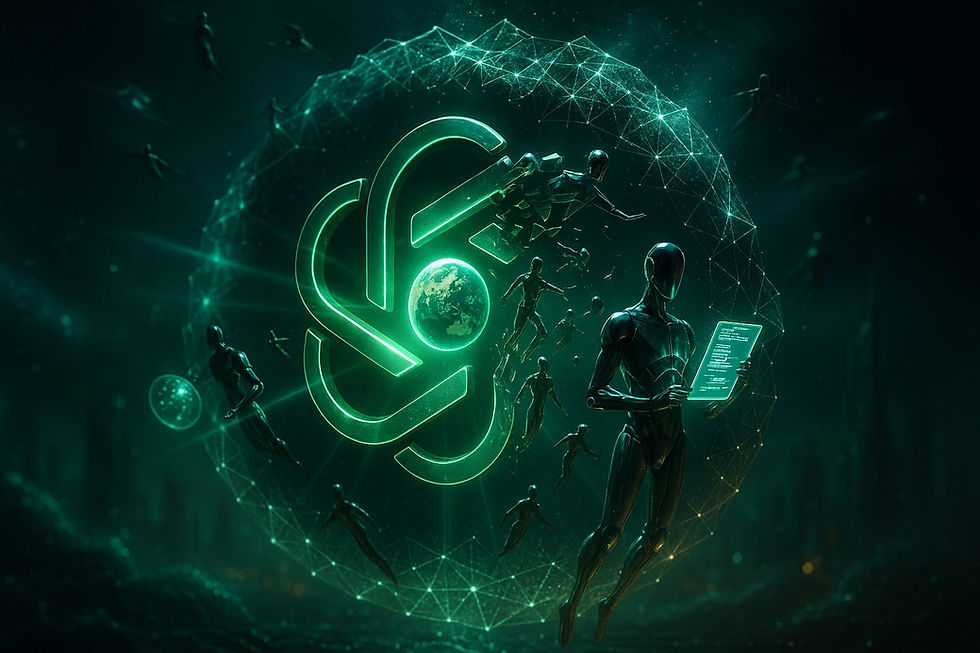ChatGPT 5.0 vs GPT-4: Updates, Comparisons, and the Future of Generative AI – What to Expect from GPT-6?
- Nexxant

- Aug 11
- 11 min read

Introduction
ChatGPT 5.0 represents the latest major leap in the evolution of OpenAI's language models, solidifying its position as a benchmark in the world of generative AI. This version is more than just an incremental update; it brings significant advancements in extended context, multi-step logical reasoning, and advanced personalization. These features are crucial for a wide range of users, from individuals to large corporations and developers.
For the general public, the importance of this new model lies in its ability to generate more coherent and accurate responses that adapt to the user's conversational style. For corporate teams, GPT-5 paves the way for more efficient AI agents that can be integrated into complex workflows. Meanwhile, developers gain access to new APIs and functionalities, enabling them to build more robust solutions with less need for manual fine-tuning.
This launch reinforces a trend seen since 2018: with each new version, not only do processing capabilities grow, but so do expectations about the role of artificial intelligence in content production, process automation, and decision-making. In a landscape where AI safety and ethics are increasingly relevant, ChatGPT 5.0 promises to significantly reduce hallucinations and offer a more mature balance between creativity and reliability. And there’s more: ChatGPT 5.0 is free for all users! Paid plans offer extras such as less restricted access to Sora, plugins, and the ability to generate more content daily in the Chat (something you’ll only notice if you produce a LOT of long-form content).
2. The ChatGPT Timeline: From 1.0 to 5.0
The journey of ChatGPT is marked by a series of gradual advancements and paradigm shifts in how we interact with machines.

ChatGPT 1.0 and 2.0 — The Early Days (2018–2019)
The first versions, based on the GPT-1 and GPT-2 models, were limited in their ability to maintain context and consistency. While they showed potential for text generation, they were prone to incoherence and generic responses. Their use was largely restricted to academic research and experiments, with minimal commercial appeal.
ChatGPT 3.0 and 3.5 — The Breakthrough (2020–2022)
With GPT-3, the leap in the number of parameters and semantic understanding allowed for richer and less fragmented dialogues. The 3.5 version, released in 2022, is best known for making ChatGPT a product accessible to the general public, leading to its massive adoption for writing, coding, and customer support. This era marked the first serious attempts at deploying commercial-scale AI agents.
ChatGPT 4.0 / 4o — Precision and Multimodality (2023–2024)
GPT-4 brought remarkable improvements in factual accuracy and multimodal comprehension, enabling it to interpret and generate text from images while handling more complex instructions. The 4o version, optimized for speed and cost, expanded its integration with virtual assistants and enterprise tools, as well as enhancing AI safety and ethics.
ChatGPT 5.0 — The Qualitative Leap (2025)
GPT-5 introduces concrete advancements, including a context window of up to 256,000 tokens, a reasoning ability that is closer to human-like thought processes, a significant reduction in hallucinations, and native multimodal integration (text, image, audio, and in some cases, video). The model also debuts a persistent personalization system, where a user's preferences for tone, format, and depth are remembered across interactions, moving the AI's behavior closer to that of a continuous cognitive agent.
3. Core Features of ChatGPT 5.0
ChatGPT 5.0 is more than an incremental update; it represents a strategic redesign of OpenAI's core processing engine. The new architecture incorporates advancements in Large Language Model (LLM) technology, context engineering, and multimodal integration. Each feature is designed to enhance the user experience across three key fronts: response quality, operational efficiency, and customization capabilities.
3.1 Extended Context
GPT-5 expands the context window to up to 256,000 tokens in its premium version, which is equivalent to hundreds of pages of text analyzed at once. This allows it to maintain coherence in lengthy dialogues, work with extensive documents, and perform data analysis without information fragmentation. For example, a researcher can provide a complete academic study and discuss methodological nuances without the model "forgetting" crucial parts of the text—a challenge that previous versions like GPT-4 had to overcome with partial summaries.
3.2 Accuracy and Consistency
The new multi-step logical reasoning engine and a refined internal checking system have significantly reduced AI hallucinations. OpenAI claims that internal benchmarks show up to a 38% improvement in factual accuracy for specific knowledge queries compared to GPT-4. This directly impacts fields like technical support, jurisprudence, and scientific research, where the margin for error must be minimal.
3.3 Logical and Multi-Step Reasoning
While GPT-4 made strides in this area, GPT-5 demonstrates a greater ability to plan chained responses, document its line of reasoning, and adapt its solution in the face of new variables. This is particularly relevant for autonomous AI agents that need to execute complex, sequential tasks, such as preparing financial reports by cross-referencing multiple data sources in real-time.
3.4 Multimodal Understanding
GPT-5 natively integrates text, images, and audio, and specific versions are already testing video interpretation. This multimodal comprehension is not just descriptive: the model can analyze a chart a user sends, correlate it with textual data, and suggest additional visualizations. For businesses, this means the assistant can act as a true hub for information analysis, reducing the dependency on multiple tools.
3.5 Advanced Personalization
One of the most valued innovations for recurring users is the persistent profile. Unlike the experimental "memory mode" in GPT-4, the new model can now retain preferences for language, formality, goals, and even common technical terms used by the interlocutor. For an attorney, this means receiving responses already formatted with legal citations and petition structures, without having to repeat instructions in every session.
3.6 Efficiency and Speed
With optimizations in the inference pipeline, GPT-5 shows up to a 40% reduction in average response latency, especially in its GPT-5 mini variant, which is designed for tasks requiring speed and lower cost. This performance makes the technology more accessible for real-time integrations, such as virtual assistants and voice interfaces.
3.7 Tool Integration
GPT-5 comes with native connectors for popular services like Google Workspace and Microsoft 365, as well as direct integration with Siri on Apple devices. Additionally, expanded API support facilitates the creation of customized AI agents capable of orchestrating complex workflows—from automating emails to executing industrial processes.
4. Comparing ChatGPT 5.0 to Previous Versions
The arrival of ChatGPT 5.0 marks a more profound transition than seen in past updates. When directly comparing it to GPT-4, the advancements aren't limited to an increase in parameters; they involve fundamental changes in how the model interprets, organizes, and delivers information.
4.1 GPT-4 vs. GPT-5: Context, Accuracy, and Adaptability
GPT-4 was celebrated for its substantial improvement in factual accuracy and the introduction of basic multimodality. However, it still faced context limitations (around 32,000 tokens at its maximum configuration) and required manual adjustments to maintain coherence in long dialogues. GPT-5, on the other hand, expands the context window to 256,000 tokens, refines its multi-step logical reasoning, and significantly reduces AI hallucinations thanks to a more robust internal information verification system. Furthermore, its multimodal comprehension goes beyond simple description, with the ability to correlate data between text, images, and audio to generate more precise insights.
Another key point of adaptation is the persistent profile. In GPT-4, user preferences could only be partially remembered, and this feature was still experimental. In GPT-5, this function is a core part of the system, enabling a truly continuous and personalized experience.
4.2 Impact for End Users
For the general public, the main difference is the seamlessness of the interaction and the maintenance of context. With GPT-4, long discussions often required re-entering information to prevent context loss. Now, with GPT-5, it's possible to conduct complex conversations—like planning trips, analyzing documents, or developing projects—without the system "forgetting" critical details. Another major gain is in response speed: the GPT-5 mini variant can interact in near real-time, greatly improving the user experience for virtual assistants and voice interfaces.
4.3 Impact for Businesses and Developers
In the corporate world, GPT-5 represents a major leap in intelligent automation and integration with external tools. The expanded API compatibility and native connectors (like Google Workspace, Microsoft 365, and Siri) make it easier to create specialized AI agents. Companies in sectors like law, finance, and engineering are already exploring GPT-5's greater precision and consistency to reduce rework and speed up processes. For developers, the expanded context and latency optimization allow for the creation of more complex applications, such as chatbots with long-term memory, multimodal data analysis systems, and assistants that act as real-time process orchestrators.
Follow a summary on comparison table:
Aspect | ChatGPT GPT-4.0 | ChatGPT GPT-5.0 | Evolution and Real Benefits |
Expanded Context Capacity | Up to 32,000 tokens in the most advanced version | Up to 256,000 tokens | Enables much longer data analysis and conversations without losing information |
Improved Factual Accuracy | High, but still with occasional errors | Drastically reduced hallucinations with internal data verification | More reliable answers for research, business, and academic use |
Multi-step Logical Reasoning | Good performance, but limited in long processes | Optimized processing for complex reasoning chains | More sophisticated decision-making and planning |
Complex Process Execution | Requires more detailed prompts | Able to plan and execute multiple steps more autonomously | Ideal for automation and corporate strategies |
Advanced Multimodality | Interprets text and images separately | Text, image, and audio with cross-data analysis | Richer and more contextualized responses |
Persistent Memory | Experimental and partial | Integrated and personalized memory for each user | Continuous experience tailored to the user profile |
Long Conversation Context | Can lose history | Keeps full context without repetition | Natural flow for corporate and personal chats |
Response Speed | Good, but with noticeable latency | GPT-5 mini delivers near-instant replies | Better experience in chatbots and voice assistants |
Function Calling and Tools | Basic integration | Enhanced support for multiple tools and APIs | Automatic execution of tasks and queries |
Corporate Integration | Limited and manual | Native connectors for Google Workspace, Microsoft 365, Siri | Frictionless system automation and integration |
Enterprise Use | Good support, but scalability limits | Intelligent automation for sectors like legal and finance | More productivity and less rework |
5. Practical Examples
To understand where ChatGPT 5.0 truly differs from GPT-4, it's helpful to look at real-world scenarios where the technological evolution directly impacts the quality of the results.
5.1 Solving Complex Problems
Imagine a civil engineering consultant who needs to analyze a 200-page slope containment plan, complete with images and tables. With GPT-4, even with its strong processing power, the content would need to be fragmented into multiple steps due to context limitations. In contrast, GPT-5, with its 256,000 token capacity, can process the entire document at once, correlate textual and visual data, and present a cohesive technical opinion. This opinion would include multi-step logical reasoning that explains the sequence of suggested decisions. This advancement is particularly useful in fields like engineering, law, and scientific research, where losing context can compromise a complete analysis.
5.2 Step-by-Step Reasoning
Another practical difference is the clarity with which GPT-5 documents its thought process. In a test conducted by Stanford University researchers in partnership with OpenAI engineers, the model was challenged to calculate the financial viability of a solar energy project, considering market variables, taxation, and demand projections. GPT-5 not only presented the final result but also a detailed step-by-step breakdown, listing assumptions, applied formulas, and data sources. This is a significant improvement over GPT-4, which often delivered results in a condensed and less transparent format.
5.3 Long-Term Memory
The persistent profile feature of GPT-5 allows for interactions that simulate long-term memory. For instance, an attorney who configured the model to always respond with references to ABNT standards and recent jurisprudence no longer needs to repeat this instruction in future conversations. GPT-5 maintains this pattern, adapting the tone and structure of its responses to the user's profile, making the tool feel more like a personal AI agent. This feature was experimental in GPT-4 and often lost consistency between sessions.
6. Current Limitations
Despite its advancements, ChatGPT 5.0 is not without its technical restrictions and conceptual challenges.
6.1 Dependence on Training Data
The model is still highly dependent on the quality and breadth of its training data. Although OpenAI has expanded the dataset to include more recent and diverse sources, GPT-5 may not reflect the very latest events or discoveries when accessed without integration with search tools. This particularly affects users who expect real-time answers without relying on external plugins.
6.2 Interpreting Subjective Nuances
Questions involving high subjectivity, such as analyzing emotional tone in ambiguous texts or cultural interpretation in specific contexts, still have a margin for error. In tests conducted by analysts at the MIT Media Lab, GPT-5 showed improvements over GPT-4 but still did not achieve total accuracy in cases of intentional ambiguity or culturally specific sarcasm.
6.3 Ethical Issues and Bias
The reduction of AI hallucinations does not eliminate the possibility of biased responses. OpenAI maintains filtering and auditing mechanisms, but the debate on AI safety and ethics remains relevant. The risk of replicating biases present in training data—whether related to gender, ethnicity, or ideology—still requires constant attention, especially in sensitive applications like recruitment, assisted judicial decisions, or medical screening.

7. What to Expect from Future Versions (6.0 and Beyond)
While ChatGPT 5.0 marks a significant milestone in the evolution of Large Language Models (LLMs), OpenAI's development trajectory suggests there is still room for substantial advancements in future generations—whether it's in GPT-6 or in intermediate versions.
7.1 Expansion of AI Autonomy
The natural progression points toward increasingly independent AI agents that can make decisions with minimal human intervention. The goal is for these agents to execute complex chains of tasks—such as planning, research, negotiation, and execution—with supervision only at critical points. Researchers from OpenAI and academic partners at MIT and Carnegie Mellon University are already testing prototypes that can monitor, review, and correct their own output before final delivery.
7.2 Enhancements in Multimodal Comprehension
The advancement of multimodal comprehension is expected to become more profound. This means the model will not only process text, images, audio, and video simultaneously but will be able to identify complex semantic relationships between them. Imagine a maintenance engineer sending an inspection video and the assistant automatically generating a technical report with suggestions for parts and replacement deadlines—all in a single workflow.
7.3 Real-Time Cultural Translations and Interactions
While GPT-5 already shows progress in automated translations, there is still room for more accurate cultural fidelity. Future versions should integrate broader regional linguistic databases, allowing for idioms, accents, and cultural contexts to be preserved in real-time. This will benefit everything from international negotiations to multilingual technical support.
7.4 Near-Total Reduction of "Hallucinations"
The complete elimination of AI hallucinations is a stated but challenging goal. It is likely that future versions will incorporate hybrid systems that combine neural inference with symbolic verification and direct queries to updated databases, creating a real-time checking layer before delivering the final response.
7.5 More Proactive and Personalized Interactions
Personalization will advance to a point where the assistant can anticipate needs, suggesting actions before they are even requested. This will require careful modeling of privacy and security to avoid overreach and maintain user trust.
8. Where to Access the Official Version
Due to the hype, many unofficial links are being shared — and some are not trustworthy.
You can use ChatGPT directly on the official website: chatgpt.com.
Mobile App
In addition to browser access, you can also use the ChatGPT app. You can download the official ChatGPT app from the official stores:
iOS (App Store): Free official app, syncs your history, and offers features like voice mode and image generation.
Android (Google Play Store): Free official app, with history synchronization and access to new features like the image generator.
For convenience, the website chatgpt.com/download provides download options for iOS, Android, and desktop (Windows/macOS).
Conclusion
ChatGPT 5.0 is more than just an update; it is a clear indicator that we are approaching a new level where generative AI, AI agents, and multimodal comprehension converge to create systems capable of understanding, reasoning, and acting in ways that are increasingly closer to human cognition.
Its impact is felt by both the general user—who now has access to a more coherent, fast, and adaptable assistant—and by businesses and developers, who can explore new forms of automation and integration with critical tools.
However, the user's role remains decisive: the more well-defined the instructions, the more precise the responses will be. AI safety and ethics continue to be central topics, and awareness of responsible use of the technology is just as important as the technical advancements.
The future points toward more autonomous models that can interact proactively, maintain long-term dialogues, and operate as true cognitive partners. It is up to us to explore these new functions, adapt processes, and prepare for the next major transformation that GPT-6 and beyond will bring to the digital ecosystem.
Enjoyed this article? Share it on social media and continue to follow us to stay tuned on the latest in AI, breakthroughs and emerging technologies.
Thanks for your time!😉




Comments